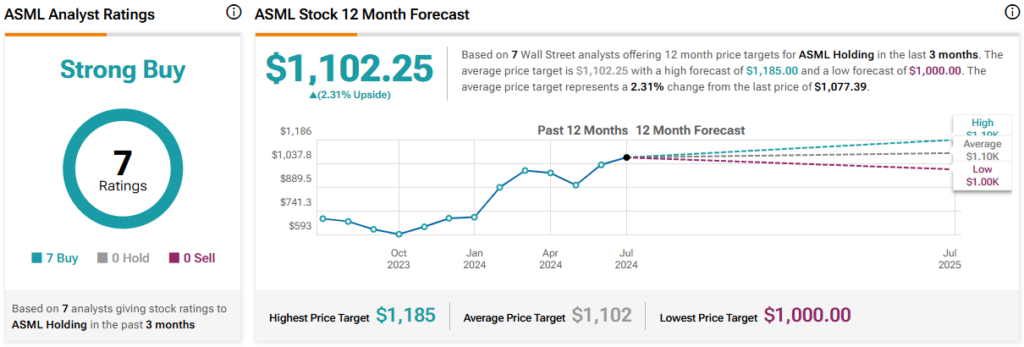ASML (NASDAQ:ASML) stock has surged this year, marking a shift from the previous two years, during which returns had been fairly lackluster. The company’s current premium valuation reflects the projections for a recovering semiconductor industry in 2025, as well as ASML’s monopoly on EUV lithography technology. I’m bullish on ASML and believe it’s poised to outperform over the long run, but I realize that there may be better entry points following the recent surge.

ASML Is the Kingpin
ASML plays a crucial role in the semiconductor manufacturing ecosystem as the leading provider of photolithography machines, particularly extreme ultraviolet (EUV) lithography systems. This EUV lithography technology allows its clients to create the smallest, most advanced semiconductor nodes.
Moreover, ASML is incredibly dominant in this lithography market, with an 82.9% market share. This makes it a kingpin or key enabler of several important sectors, including mobile communications, data centers, and artificial intelligence (AI).
ASML’s lithography machine transfers carefully designed patterns onto silicon wafers, which is one of the most important steps in chip production. The EUV machines are sold to clients like TSMC (NYSE:TSM), which use them in their foundries.
In turn, TSMC — the world’s largest dedicated semiconductor foundry — manufactures chips designed by companies like Nvidia (NASDAQ:NVDA), which is a fabless semiconductor company that designs graphics processing units (GPUs) and other high-performance processors but does not have its own manufacturing facilities.
Things Should Get Better for ASML
The semiconductor industry entered a cyclical downturn between 2022 and 2024. During the latter part of the pandemic, companies around the world pointed to an undersupply of semiconductors that visibly manifested itself in a shortage of new cars. However, that undersupply turned to oversupply, which hurt many of ASML’s customers and negatively impacted sales growth.
The impact of this oversupply may have lingered into 2024, with the company’s first-quarter earnings disappointing investors in April. The Q1 data showed that year-over-year revenue growth was down 21% and missed analysts’ expectations by 1.6%. Management highlighted in theearnings callthat the industry had expected a relatively weak start to the year and had forecasted “a recovery from the downturn.”
One of the most disappointing parts of the results report was new bookings, which came in at €3.6 billion. That was far behind analysts forecasts, which was for €5.4 billion of new bookings on the back of a booming AI sector. Management responded by stating that its order flow can be a little “lumpy” and that an order rate of €4 billion per quarter would satisfy the company’s objectives.
However, ASML is expected to benefit from an uptrend in semiconductor demand, driven by secular trends in artificial intelligence, electric vehicles, and clean energy. These sectors are expected to spur demand for the most advanced chipmaking technologies. ASML believes it needs to prepare for an uptick in the number of fabs globally.
Is ASML Worth Its Premium?
ASML trades at a premium to other semiconductor equipment manufacturers due to the size of its monopoly. This monopoly also gives it pricing power, which is manifested in the 51% gross margin achieved during the first quarter. ASML is currently trading at 54.7x non-GAAP TTM earnings and 52.27x non-GAAP forward earnings. This is expensive, even for the sector.
However, analysts expected earnings per share (EPS) to grow by 23.73% annually over the medium term. This means that the forecasted EPS of $20.50 in 2024 is expected to surge to $65.84 by the end of the decade. This also results in a price-to-earnings-to-growth (PEG) ratio of 2.2x (1.0x or lower is generally seen as undervalued).
Personally, I recognize that investors should always be cautious when investing based on forecasted growth. Analysts can be way off with their forecasting, and this can prove problematic for investors who have put their money into a “high potential” stock. However, I do have a good degree of confidence in the current forecast and believe that the aforementioned changes are hugely significant for the global economy.
Notably, I find ASML’s PEG ratio slightly problematic. This is some distance above the figures that I would normally consider attractive. Still, given ASML’s dominance in the lithography sector, it is arguably justified.
Is ASML Stock a Buy, According to Analysts?
On TipRanks, ASML comes in as a Strong Buy based on seven Buys, zero Holds, and zero Sell ratings assigned by analysts in the past three months. The average ASML stock price target is $1,102.25, implying 2.3% upside potential.

The Bottom Line on ASML Stock
ASML stock certainly isn’t cheap on near-term metrics, and it can be risky to put all our faith behind forecasts rather than near-term value. However, if there is one company that deserves to trade at a premium, it’s ASML. It has a dominant market share, sizeable gross margin, and an enabling position within booming industries, notably AI, clean energy, and EVs.
The views and opinions expressed herein are the views and opinions of the author and do not necessarily reflect those of Nasdaq, Inc.


